Corsair HX850 PSU Review
Why you can trust Tom's Hardware
Transient Response Tests
Advanced Transient Response Tests
For details on our transient response testing, please click here.
Ιn these tests, we monitor the HX850's response in several scenarios. First, a transient load (10A at +12V, 5A at 5V, 5A at 3.3V, and 0.5A at 5VSB) is applied for 200ms as the PSU works at 20 percent load. In the second scenario, it's hit by the same transient load while operating at 50 percent load.
In the next sets of tests, we increase the transient load on the major rails with a new configuration: 15A at +12V, 6A at 5V, 6A at 3.3V, and 0.5A at 5VSB. We also increase the load-changing repetition rate from 5 Hz (200ms) to 50 Hz (20ms). Again, this runs with the PSU operating at 20 and 50 percent load.
The last tests are even tougher. Although we keep the same loads, the load-changing repetition rate rises to 1 kHz (1ms).
In all of the tests, we use an oscilloscope to measure the voltage drops caused by the transient load. The voltages should remain within the ATX specification's regulation limits.
These tests are crucial because they simulate the transient loads a PSU is likely to handle (such as booting a RAID array or an instant 100 percent load of CPU/GPUs). We call these "Advanced Transient Response Tests," and they are designed to be very tough to master, especially for a PSU with a capacity of less than 500W.
Advanced Transient Response at 20 Percent – 200ms
| Voltage | Before | After | Change | Pass/Fail |
|---|---|---|---|---|
| 12V | 12.045V | 11.986V | 0.49% | Pass |
| 5V | 5.031V | 4.939V | 1.83% | Pass |
| 3.3V | 3.319V | 3.247V | 2.17% | Pass |
| 5VSB | 5.014V | 4.986V | 0.56% | Pass |
Advanced Transient Response at 20 Percent – 20ms
| Voltage | Before | After | Change | Pass/Fail |
|---|---|---|---|---|
| 12V | 12.047V | 11.971V | 0.63% | Pass |
| 5V | 5.030V | 4.920V | 2.19% | Pass |
| 3.3V | 3.319V | 3.238V | 2.44% | Pass |
| 5VSB | 5.013V | 4.976V | 0.74% | Pass |
Advanced Transient Response at 20 Percent – 1ms
| Voltage | Before | After | Change | Pass/Fail |
|---|---|---|---|---|
| 12V | 12.046V | 11.972V | 0.61% | Pass |
| 5V | 5.031V | 4.932V | 1.97% | Pass |
| 3.3V | 3.319V | 3.228V | 2.74% | Pass |
| 5VSB | 5.014V | 4.971V | 0.86% | Pass |
Advanced Transient Response at 50 Percent – 200ms
| Voltage | Before | After | Change | Pass/Fail |
|---|---|---|---|---|
| 12V | 12.008V | 11.950V | 0.48% | Pass |
| 5V | 5.019V | 4.935V | 1.67% | Pass |
| 3.3V | 3.312V | 3.238V | 2.23% | Pass |
| 5VSB | 4.996V | 4.965V | 0.62% | Pass |
Advanced Transient Response at 50 Percent – 20ms
| Voltage | Before | After | Change | Pass/Fail |
|---|---|---|---|---|
| 12V | 12.010V | 11.938V | 0.60% | Pass |
| 5V | 5.019V | 4.914V | 2.09% | Pass |
| 3.3V | 3.312V | 3.223V | 2.69% | Pass |
| 5VSB | 4.995V | 4.949V | 0.92% | Pass |
Advanced Transient Response at 50 Percent – 1ms
| Voltage | Before | After | Change | Pass/Fail |
|---|---|---|---|---|
| 12V | 12.007V | 11.926V | 0.67% | Pass |
| 5V | 5.020V | 4.911V | 2.17% | Pass |
| 3.3V | 3.313V | 3.222V | 2.75% | Pass |
| 5VSB | 4.997V | 4.949V | 0.96% | Pass |



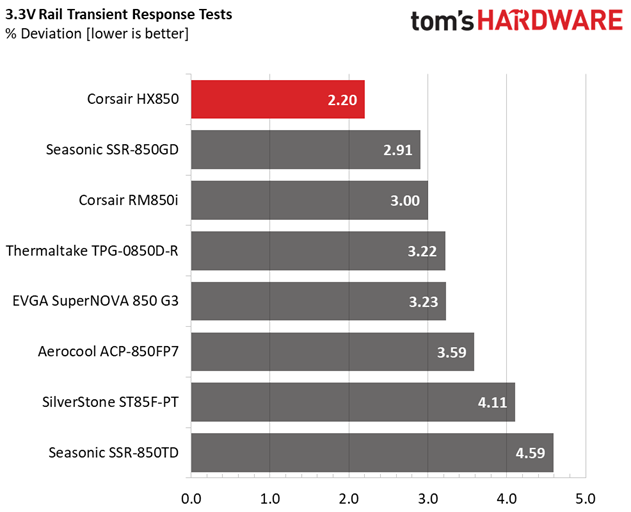

The rails fare well in our tough advanced transient response tests. Even the 3.3V rail, which usually exceeds 3%, stays inside that threshold on the HX850. Finally, the all-important +12V rail lands below 0.7% in our worst-case scenario.
Get Tom's Hardware's best news and in-depth reviews, straight to your inbox.
Here are the oscilloscope screenshots we took during Advanced Transient Response Testing:
Transient Response At 20 Percent Load – 200ms




Transient Response At 20 Percent Load – 20ms
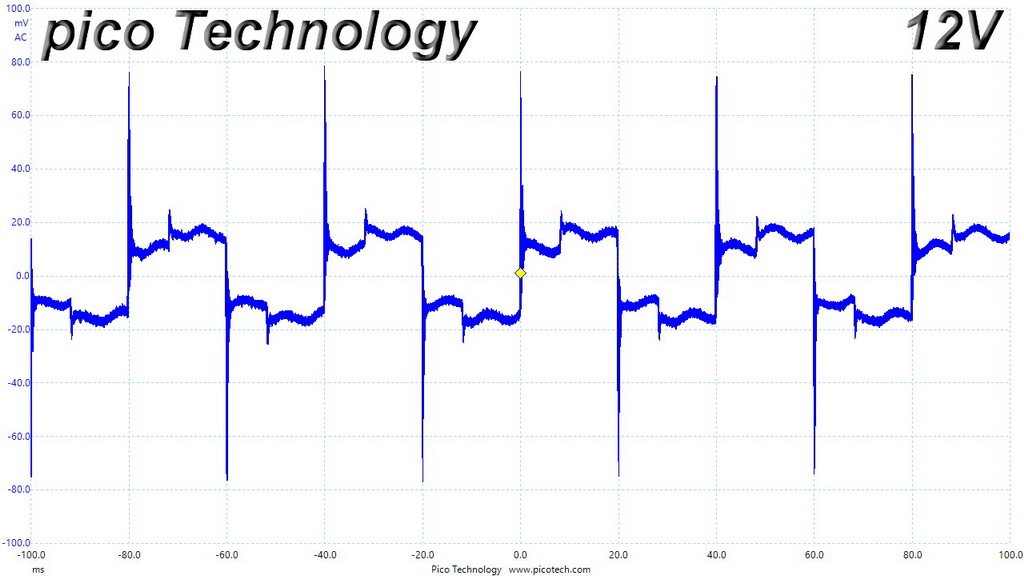



Transient Response At 20 Percent Load – 1ms


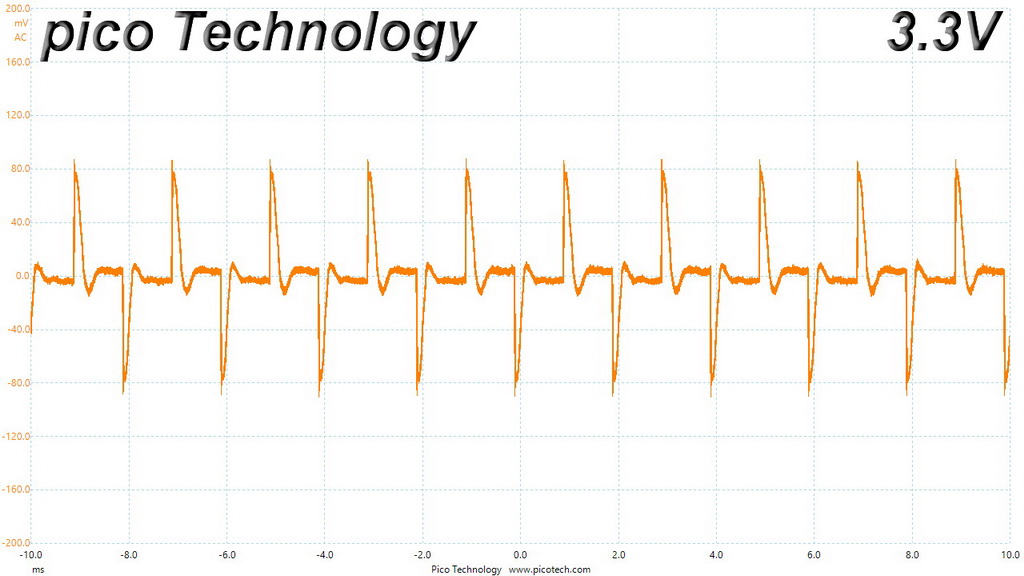

Transient Response At 50 Percent Load – 200ms


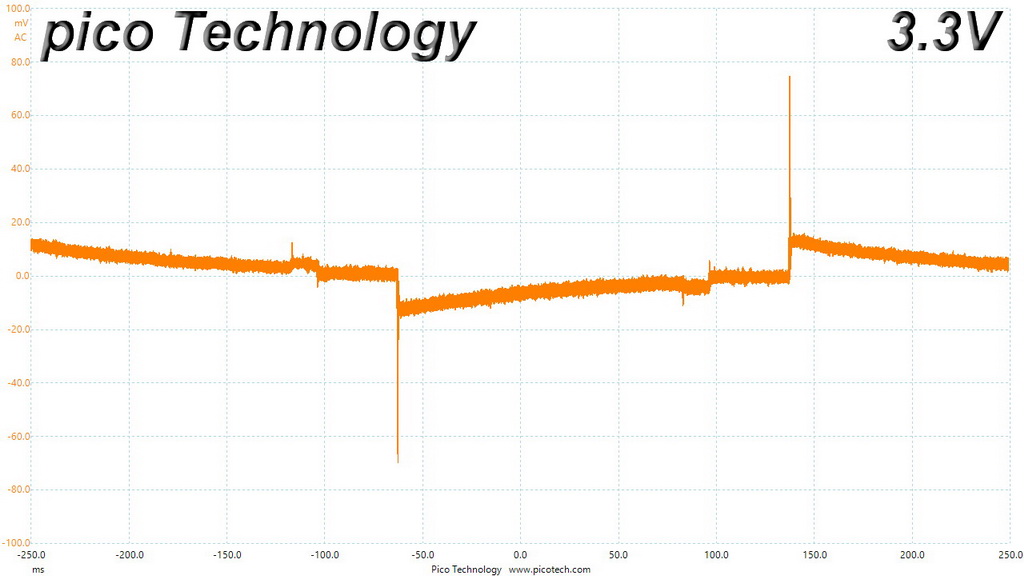

Transient Response At 50 Percent Load – 20ms




Transient Response At 50 Percent Load – 1ms




Turn-On Transient Tests
In the next set of tests, we measure the HX850's response in simpler transient load scenarios—during its power-on phase.
For our first benchmark, we turned the HX850 off, dialed in the maximum current the 5VSB rail could output, and switched the PSU back on. In the second test, we dialed the maximum load the +12V rail could handle and started the 850W supply while it was in standby mode. In the last test, while the PSU was completely switched off (we cut off the power or switched the PSU off), we dialed the maximum load the +12V rail could handle before switching it back on from the loader and restoring power. The ATX specification states that recorded spikes on all rails should not exceed 10 percent of their nominal values (+10 percent for 12V is 13.2V, and 5.5 V for 5V).

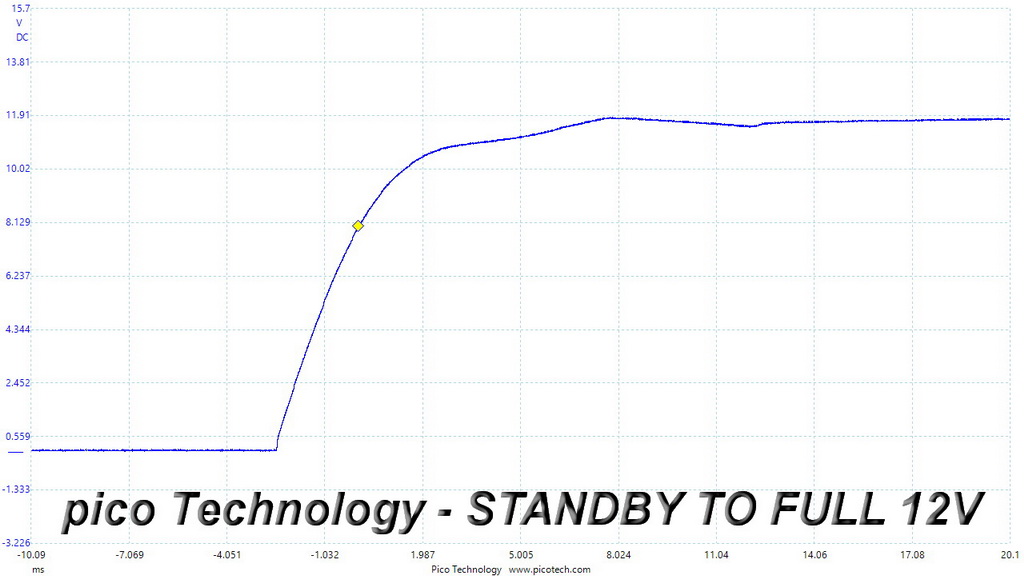

We didn't notice any voltage overshoots or spikes. There was only a small wave during the last test before the rail's voltage settled down. That's nothing to worry about.
MORE: Best Power Supplies
MORE: How We Test Power Supplies
MORE: All Power Supply Content
Current page: Transient Response Tests
Prev Page Cross-Load Tests & Infrared Images Next Page Ripple Measurements
Aris Mpitziopoulos is a contributing editor at Tom's Hardware, covering PSUs.
-
derekullo Would it be possible to do a comparison between the Corsair HX850 and the AX860?Reply
All digital sounds nice on paper, but how does it translate into power supply performance?
Does the extra $12 for the AX860 give you a quantifiable difference between them?
And if the AX860 does turn out to be superior in some way then why does the HX850 even exist in the first place?
Corsair AX860 $181.99
https://www.newegg.com/Product/Product.aspx?item=N82E16817139041
Corsair HX850 $169.99
https://www.newegg.com/Product/Product.aspx?Item=N82E16817139083
I remember back in 2002 I blew my power supply while overclocking and playing Tron 2.0 .
(The power supply didn't take out anything, just had to buy a new one.)
Ever since then I've always used the highest priced AX line, with the rationale of never going cheap on my power supply again.
(And being more conservative with my overclocks) -
Aris_Mp The AX860i has 1.42% higher overall performance score than the HX850 and the AX860 is very close to the AX860i. I would say that the performance of the AX860 and the HX850 is really close, however the second is much more silent.Reply -
ElectrO_90 The first paragraph talks about the HX850i and the new cables in this HX850.Reply
Where are the comparisons between the 2?
Why even mention it, if you aren't going to show how much better the HX850 cables are, if at all?